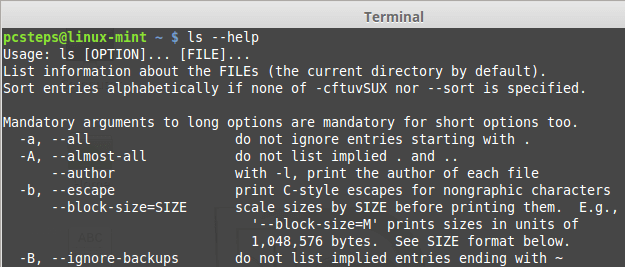

- #LIST OF COMMANDS FOR TERMINAL HOW TO#
- #LIST OF COMMANDS FOR TERMINAL PASSWORD#
- #LIST OF COMMANDS FOR TERMINAL FREE#
- #LIST OF COMMANDS FOR TERMINAL WINDOWS#
Its function is almost like the command “mv”. The command “cp” is used to copy data from a source file to the destination file. Entering the command “mv File1 File_Rename” will rename File1 to File_Rename in the same directory. File1) from the system.Ĭonsider having two files in a directory (File1 and File2). Entering the command “mv File1 File2” will move data of File1 to File2 and delete source file(i.e. Syntax: mv Source_File_name Destination_File_NameĬonsider having two files in a directory (File1 and File2).
#LIST OF COMMANDS FOR TERMINAL PASSWORD#
The command “passwd” stands for password and it is used to change the password of the user. The command “w” displays detailed information about the users who are logged into the system currently.

The result for this command includes the current time, the time duration system has been running, the number of users who are currently logged on, and the system load averages for the past 1, 5, and 15 minutes respectively. The command “uptime” provides information about how long the system has been running in one line. The ps command is commonly used with these parameters to show the process list: ps aux The command “ps” which is also known as the process status command is used to provide information about the processes currently running on the system, including their respective process identification numbers (PIDs).
#LIST OF COMMANDS FOR TERMINAL FREE#
The command “free” displays the amount of free and used memory in the complete system. The command “df -h” shows the same result as the command “df” but now the data is in a more human-readable form that can be easily comprehended by a new user. df -h displays the output in human-readable format The command “df” shows the amount of disk space used and disk space available on every file system containing each filesystem’s name and its path.Īdvertisement a. Syntax: date -d Date_to_operate_system_on To operate the system on a specific date, you can change the date by using “-d”. Linux allows its user to set the current date and time of the system manually. Linux user can change the time zone via Terminal by using command “TZ”.ī. The simple “date” command displays the current date and time (including the day of the week, month, time, time zone, year).īy default, “date” command uses the time zone defined in path “/etc/localtime”. Commands used for System Information date

#LIST OF COMMANDS FOR TERMINAL HOW TO#
Here we present the basic but very important Ubuntu commands to give you an in-depth knowledge of how to use your Linux terminal.
#LIST OF COMMANDS FOR TERMINAL WINDOWS#
A lot of people find Linux more challenging as an operating system especially when they are coming from the comfort of using Windows or macOS. However, being a newbie, you might find its Command Line Interface (CLI) a little intimidating. The world of Ubuntu welcomes you and it is ready to grant you all the power over your system.


 0 kommentar(er)
0 kommentar(er)
